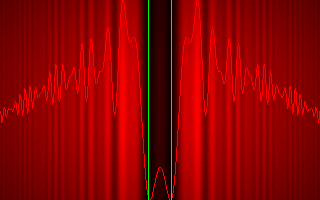Laser Diffraction
Computer Simulation
This basic program computes the diffraction pattern of
a laser beam incident on various targets such as a slit,
double slit, wire, edge or rectangular aperture.
 Sample output from DIFFRACT.BAS.
Sample output from DIFFRACT.BAS.
Diffraction pattern of a thin wire obstacle using a
red helium-neon laser with gaussian beam. The central
portion of the pattern is a brighter red than the edges because
of the radial exponential fall-off of the laser beam cross-section.
In practice, this is exactly what you see in the lab.
The green lines are the projected boundaries of the
geometrical shadow of the wire.
There is also a graph overlay in red.
Details
The beam can be uniform isotropic or with gaussian profile.
The laser diffraction pattern can scanned in 1D or 2D and
can be plotted to the screen as
a graph and/or as a color coded intensity plot.
There is a much higher resolution laser printer output option and
there are plans for high resolution VRML output in the Java version.
References
For more information and experimental results read
'laser diffraction'
(available in WordPerfect format also).
This paper describes the above program and several others to test
the accuracy and computational efficiency of various schemes to
calculate Fresnel integrals (works on any computer)
and to produce
diffraction pattern animations
(works only on an
Amiga
computer) as one or more parameters are sweeped from a minimum to a maximum.
There is also a related project to determine the
'Effects of polarization on diffraction patterns'.
These programs are currently undergoing conversion into Java applets.
There is
two-slit diffraction simulation
Java applet by Serge Vtorov.
 Laser Stars Home
Laser Stars Home
 Sample output from DIFFRACT.BAS.
Sample output from DIFFRACT.BAS.